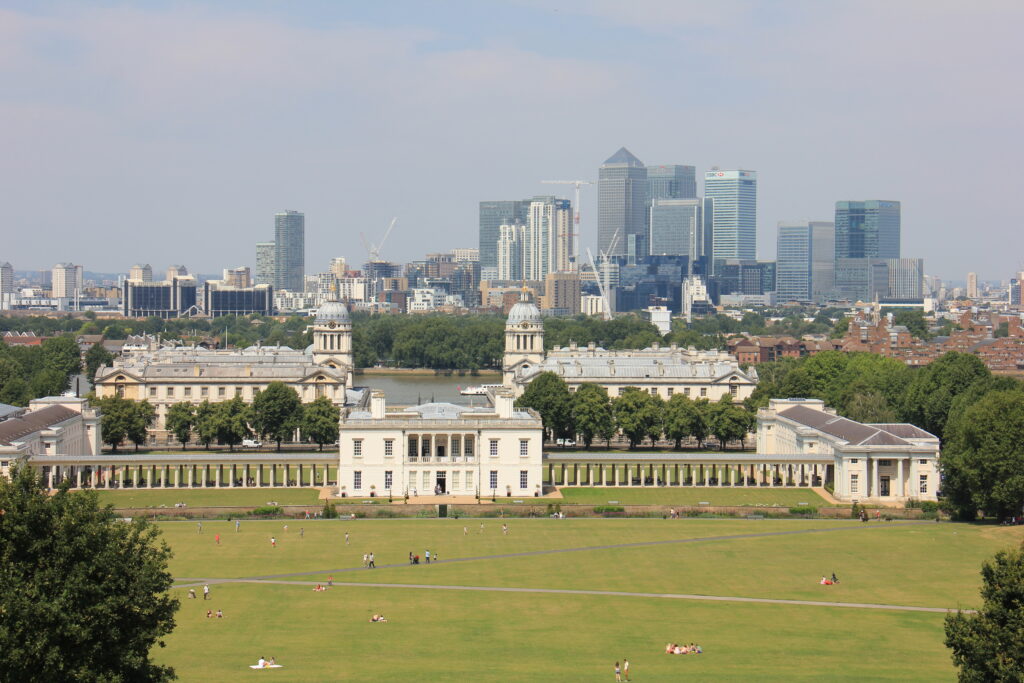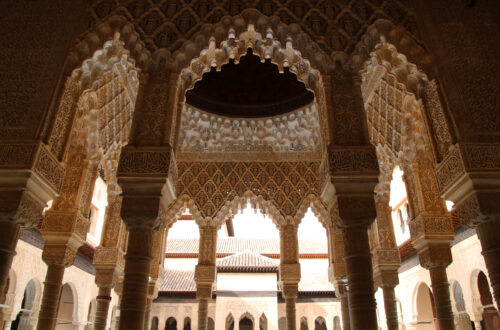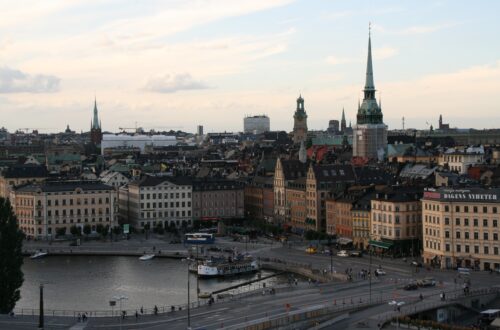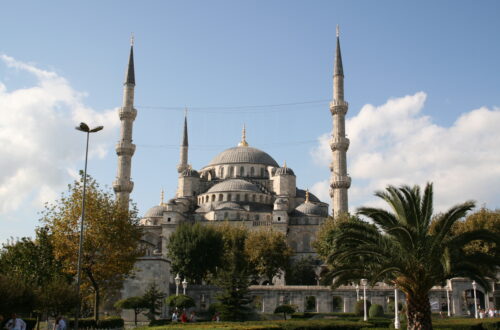
London, UK
West End
After a short flight of barely fifty minutes, we land at Gatwick Airport, about 45 kilometers south of London. It’s another half hour with the Gatwick Express to Victoria Station and fifteen minutes by tube to our hotel in the Bayswater district, north of the Kensington Gardens. After leaving our luggage there, it’s time to see the city. We start in West End, at the impressive Palace of Westminster, better known as the Houses of Parliament. A large neo-gothic building from the nineteenth century that sits right on the River Thames. This is where the House of Commons and the House of Lords meet. The Elisabeth Tower, better known as Big Ben, is part of the Houses of Parliament. Big Ben is actually the name of the 13-ton bell that hangs at the top of the tower. As we walk across the bridge to the other side of the river, we hear the heavy sound of the clock, indicating that it is noon.
Behind the Houses of Parliament is Westminster Abbey. This is where British monarchs are crowned and most are buried there after their deaths. Built between the twelfth and sixteenth centuries, the complex of buildings once served as a Benedictine monastery until it became part of the Church of England in 1536. Then we walk down Whitehall and past Downing Street. The home of the British Prime Minister is located at number 10 of this heavily guarded street, which is not open to the public. At first sight it is a simple gray brick mansion. The street scene in the city has been determined for decades by the red double-decker buses and the black cabs. They’ve been moderned a bit over the years, but when you’re walking down the street, you can’t possibly be mistaken: this is London.

It’s a beautiful sunny day, so it’s not surprising that Trafalgar Square is quite busy with people soaking up the sun. Here we have lunch, on the edge of one of the fountains and overlooking the column in the middle of the square. On top of the column is Admiral Nelson, who led the British fleet that defeated Napoleon in 1805. On the north side of the square is the National Gallery. Here you can see a large collection of paintings, made between the thirteenth and early twentieth centuries, including Dutch masters like Van Gogh and Rembrandt.
We walk on, past Piccadilly Circus and then via Regent Street to St. James’s Park. This beautiful park is a green oasis in the middle of the busy city and crowded on nice days like this. On the north side of the park is Buckingham Palace, built in 1705 and the residence of the British monarch since 1837. In front of the palace, where the changing of the guard draws hordes of tourists daily, is a 25-meter high gold statue of Queen Victoria. In the adjacent Green Park we relax for a while and then we walk to the SoHo district, a cozy neighborhood with many restaurants and pubs, including the Peruvian restaurant Ceviche, where we end the day with a well-deserved beer and good food.
City
The next morning we take the metro from our hotel to The City. Here we first walk to Tower Bridge, one of the most iconic bridges in the world. The name of the bridge refers not only to the two neo-Gothic towers of the bridge itself, but also to the adjacent Tower of London. Originally built in the eleventh century by William the Conqueror, this castle has had various functions over time, including palace, warehouse and prison. From the castle walls you have a beautiful view of the inner courtyard with the central White Tower as well as the River Thames and Tower Bridge.

Traitor’s Gate is located in the south wall of the castle. Here prisoners were sailed straight in from the Thames. Thomas More was imprisoned in the Bell Tower before he was beheaded here on Tower Hill in 1535 for not wanting to recognize King Henry VIII as head of the Church of England. A tall, yellowish building on the north side of the courtyard are the Waterloo Baracks. This is where the British Crown Jewels are kept, including gem-encrusted crowns and sceptres and silver dinnerware used at state banquets. Built in 1078, the central White Tower now houses an exhibition of weapons and armor from that era.
After the Tower we sit on a terrace with a cup of coffee. It has been sunny and warm all morning, but it will become more changeable in the early afternoon. In the course of the afternoon a few heavy showers fall, but in between the sun also shines. It will be the only rain during our five days in London. Between the showers we walk past The Monument, a sixty meter high Doric column from 1677, in memory of the great fire in 1666, which destroyed a large part of the city. Then we visit Leadenhall Market, a covered shopping arcade from the late nineteenth century, which now mainly houses luxury shops and restaurants. And where drinks are served early on this Friday afternoon.

We are now in the heart of the City of London, one of the most important financial centers in the world. Here big money is made by banks and investment companies. The City covers approximately 2.5 square kilometers, employs about 330,000 people, but only 8,000 live there. The neighborhood is a mix of old Victorian buildings and modern office towers, some of with remarkable architecturee, such as The Gherkin and Lloyd’s industrialist stainless steel building. The street scene is dominated by men in dark suits, many of whom are already standing in front of a pub with a beer, halfway through Friday afternoon. After we have walked past St. Paul’s Cathedral (from 1711), we also go for a beer at Folly, a cafe/restaurant with a cozy messy interior, where we end up staying for dinner.
South bank
Our third day in London the weather is also beautifully sunny and warm. Today we head for the Southbank, which is, as the name implies, on the south bank of the River Thames. From Westminster Bridge to Southwark Bridge there is a riverside promenade called Bankside, a pleasant walk of about a mile. From Westminster Bridge you first pass County Hill and a little further along one of London’s most eye-catching attractions: the London Eye. This 135 meter high Ferris wheel was built in 2000 and is located directly on the Thames. You really can’t miss it.

Much less striking is the Millennium Bridge, also built in 2000. This modest bridge connects Southbank to the north bank of the Thames at St Paul’s Cathedral, which dominates the skyline at this point. On the south side is Tate Modern, London’s largest museum of modern art. The museum is located in an old power station, a large brown brick building with a striking 99 meter high chimney. You enter via the former turbine hall which is impressively large. Like most museums in London, Tate Modern is free to visit (except for the temporary exhibitions). It’s a nice museum, but the art collection doesn’t really appeal to me.
After we have have coffee at the quay, we continue walking. Southbank is an old neighborhood that has been revamped over the past fifteen years. Old warehouses now house modern apartments, studios, pubs and restaurants. It is a lively area. For example, around Borough Market, an old market hall that now houses a popular market for foodies. From here it is only a short walk to London Bridge Station. Here we take the train (where the Oyster Card is also valid) to Greenwich.

It’s only a ten minute ride, but Greenwich feels like a different world. It has the atmosphere of a village, in contrast to the busy city where we come from. The Royal Observatory is located on a hill in the middle of Greenwich Park. From the seventeenth century on, the stars and planets were studied here, among other things for the navigation of ships at sea. In 1884 it was decided that the meridian running at Greenwich would become meridian zero, dividing the earth into a western and an eastern hemisphere. It was an arbitrary decision, but that hasn’t stopped tourists nearly a century and a half later from queuing for half an hour to have themselves photographed on meridian zero. From the observatory you also have a nice view over Greenwich Park and the city skyline in the background.
When we are back at the Bankside we go for a beer on the terrace of Founders Arms on the quay. The weather is nice, so the terraces are full. Then we walk to the north bank, where we have dinner at Korean restaurant Asadal.
Kensington
Our hotel is a stone’s throw from two parks that actually form one whole: Hyde Park and Kensington Gardens. Hyde Park is the smaller one, but also the most famous of the two. In the middle the two parks are separated by a lake: The Serpentine. In contrast to the neatly landscaped Green Park and St James’s Park, which we visited earlier, Hyde Park is a more expansive park with lots of lawns and Kensington Gardens a somewhat ‘wilder’ park. Speaker’s Corner is on the northeast side of Hyde Park. On Sundays, traditionally people (mainly men) stand on a soapbox or kitchen steps to enunciate their opinion. Demonstrations also take place on a regular basis. When we walk past it in the morning, no one is there yet, but in the afternoon it is a lot busier. About four men address passers-by, the Israeli-Palestinian conflict and the Islam-Christian relationship seem to be the main themes today.

We walk through Hyde Park, past The Serpentine and the Diana Memorial Fountain, in memory of the Princess of Wales who died in an accident in 1997. After having a coffee, we will visit the Natural History Museum. This museum is also located in a remarkable building, which looks a bit like a cathedral from the outside as well as from the inside in the central hall. We walk browse the busy museum, which is full of dinosaur skeletons, stuffed animals and fossils, but we don’t take the time to look at everything in detail.
The Natural History Museum is located in the South Kensington district, an expensive neighborhood with almost exclusively luxury shops. We walk along Brompton Road, where the famous department store Harrods is located. We also walk down Oxford Street, the shopping street in London for those who want to do their shopping at the large chain stores and department stores. At the end of the afternoon we drink a beer at The Coach & Horses, a pub in the SoHo district, where it is pleasantly busy and where people are having a drink both in and in front of the pubs and enjoy the beautiful weather. Then we have dinner at The Black Lion on Bayswater Road, not far from our hotel. Fish & chips, because that’s part and parcel of being in London.

Notting Hill
On our last day in London, we take a leisurely stroll in the Notting Hill area, east of Kensington. It is a quiet neighborhood that has a small town vibe. We walk along the Portobello Road, where the market of the same name is being set up (it is not very busy yet), past the house where George Orwell lived and past the bookshop that inspired the famous bookshop from the movie Notting Hill. We drink coffee and then walk back to the metro. Our last stop is the Saatchi Gallery in South Kensington. An old building, but modernly decorated, with modern art.
After this it is time to head towards Victoria Station and take the train back to Gatwick Airport. Air traffic has been delayed all day, so we get home one and a half hours later than planned. But after a very nice city trip!




